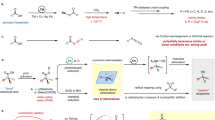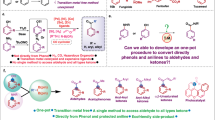Abstract
ALKALINE degradation1 has been used as a means of determining the structures of oligo- and poly-saccharides. Various alkalis have been used as degradation reagents. The barium hydroxide technique especially has been effectively used for the exploration of the chemical structure of the carbohydrate moieties of some sialomuco-proteins2–4. Under the conditions of the barium hydroxide treatment, N-acetylglucosamine5 and N-acetylneuraminic acid2 are partly converted into chromogen I (ref. 5) and N-acetylhexosamine, respectively. However, none of the reactions of N-acetylhexosamines and N-acetylneuraminic acid with barium hydroxide has as yet been completely examined. The present work was undertaken to obtain more detailed knowledge of the chromogen formation and degradation of the N-acetylhexosamines and N-acetylneuraminic acid under the conditions of barium hydroxide treatment.
This is a preview of subscription content, access via your institution
Access options
Subscribe to this journal
Receive 51 print issues and online access
$199.00 per year
only $3.90 per issue
Buy this article
- Purchase on Springer Link
- Instant access to full article PDF
Prices may be subject to local taxes which are calculated during checkout
Similar content being viewed by others
References
Whistler, R. L., and BeMiller, J. N., in Adv. Carbohydrate Chem., edit. by Wolfrom and Tipson, 13, 289 (Academic Press, New York, 1958).
Gottschalk, A., and Graham, E. R. B., Biochim. Biophys. Acta, 11, 313 (1953).
Romanowska, E., Nature, 191, 1409 (1961).
Cook, G. M. W., Nature, 195, 159 (1962).
Kuhn, R., and Krüger, G., Chem. Ber., 89, 1473 (1956); 90, 264 (1957).
Ohkuma, S., and Shinohara, T., Nature, 202, 593 (1964).
Shriner, R. L., Fuson, R. C., and Curtin, D. Y., The Systematic Identification of Organic Compounds, 111 (John Wiley and Son, Inc., New York, 1956).
Nagasawa, K., and Ohkuma, S., J. Pharm. Soc., Japan, 74, 773 (1954).
Walker, T. K., Hall, A. N., and Hopton, J. W., Nature, 168, 1042 (1951).
Cavallini, D., Frontali, N., and Toschi, G., Nature, 163, 568 (1949).
Gottschalk, A., Biochem. J., 61, 298 (1955).
Comb, D. G., and Roseman, S., J. Biol. Chem., 235, 2529 (1960).
Kuhn, R., and Brossmer, R., Liebig's Ann., 616, 212 (1958).
Roseman, S., and Comb, D. G., J. Amer. Chem. Soc., 80, 3166 (1958).
Zilliken, F., and Glick, M. C., Naturwissenschaften, 43, 536 (1956).
Ohkuma, S., Proc. Japan Acad., 38, 400 (1962).
Author information
Authors and Affiliations
Rights and permissions
About this article
Cite this article
OHKUMA, S., MIYAUCHI, C. Chromogen Formation and Degradation of N-Acetylhexosamines and N-Acetylneuraminic Acid by Barium Hydroxide Treatment. Nature 211, 190–191 (1966). https://doi.org/10.1038/211190a0
Issue Date:
DOI: https://doi.org/10.1038/211190a0
Comments
By submitting a comment you agree to abide by our Terms and Community Guidelines. If you find something abusive or that does not comply with our terms or guidelines please flag it as inappropriate.



